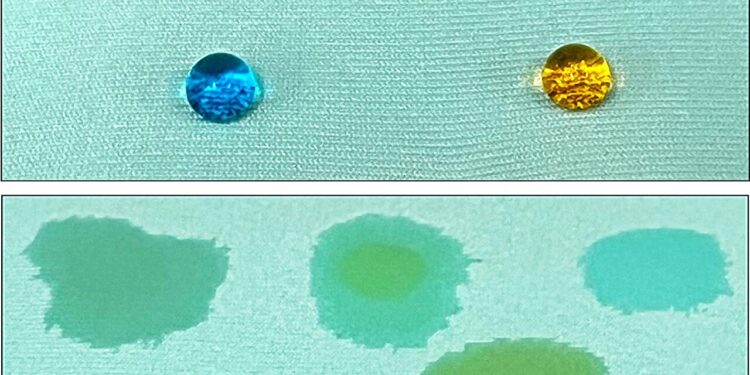Droplets of soda (left to right), water, orange juice, sports drink, and milk are shown on a piece of fabric with (top) and without (bottom) a superhydrophobic coating to organometallic structure UiO-66, developed in the laboratory. by Juan Hinestroza of the College of Human Ecology. Credit: Yelin Ko
A new technique could create waterproof coatings for clothing from discarded textiles that are far safer for humans and the environment than current coatings, which are typically made with harsh, carcinogenic chemicals.
A Cornell research group led by Juan Hinestroza, the Rebecca Q Morgan ’60 Professor of Fiber Science and Apparel Design in the College of Human Ecology (CHE), developed the low-temperature technique for the synthesis of superhydrophobic coatings ( waterproof).
“If we can keep a piece of clothing out of a landfill, then that will be a success,” Hinestroza said, noting that Americans throw away 80 to 100 pounds of clothing per person per year.
The metal-organic structure (MOF) used in the group’s coating can be synthesized at room temperature, using more environmentally friendly solvents (water and ethanol) and can be obtained without separation or purification of discarded textiles, two energy-intensive processes.
Yelin Ko, a doctoral student in the field of fiber science, is the first author of “UiO-66 Inspired Superhydrophobic Coatings Fabricated from Discarded Polyester/Spandex Textiles,” published in ACS Applied Materials and Interfaces. Hinestroza is the lead author; Tamer Uyar, associate professor of fiber science in the Department of Human-Centered Design (CHE), is the other co-author.
This research is an extension of work published in 2023 demonstrating that old clothing could be chemically broken down to reuse polyester compounds to create MOF particles with potential applications in fire resistance, antibacterial properties or wrinkle resistance . The new work takes this proof of concept and applies it directly.
In this work, metal-organic structures – unique structures developed in the 1990s by chemist Omar Yaghi, with whom Hinestroza collaborated under a Department of Defense grant in the late 2000s – were synthesized by chemically breaking down discarded polyester textiles into a heterogeneous soup containing molecules of polyester and its monomers, dyes, additives and dirt typically associated with used clothing.
The researchers exposed the discarded tissues to an alkaline depolymerization process to produce disodium terephthalate, a known binding agent for the synthesis of UiO-66, a popular MOF. They conducted experiments using different amounts of ethanol and found that with a small amount of ethanol, UiO-66 – assembled on a polyester and spandex substrate – exhibited superhydrophobic behavior.
The spandex fragments, the group found, changed the structure of the otherwise hydrophilic MOF and made it hydrophobic. Additionally, the UiO-66 material has been subjected to repeated washing and abrasion and has retained its water resistance.
The group said the technology is a way to reduce the world’s reliance on harmful chemicals in textile manufacturing.
“We need to find alternatives to fluoride finishes, also known as ‘forever chemicals,'” Uyar said. “This study demonstrates how we can achieve functional finishes, including water-repellent and self-cleaning properties, by recycling textile waste instead of relying on ‘forever chemicals’. »
The upcycling aspect of this work is the most important, Hinestroza said.
“It’s very easy to blame the brands or the producers, but in the end, they won’t produce if you don’t consume,” he said. “And everything that isn’t consumed gets thrown away. And we want to believe that the problem stops in our trash, but that’s not the case.”
More information:
Yelin Ko et al, UiO-66-inspired superhydrophobic coatings made from discarded polyester/elastane textiles, ACS Applied Materials and Interfaces (2024). DOI: 10.1021/acsami.4c10459
Provided by Cornell University
Quote: Low-temperature synthesis technique uses recycled textile waste to create safe, green waterproof coating (October 9, 2024) retrieved October 9, 2024 from
This document is subject to copyright. Except for fair use for private study or research purposes, no part may be reproduced without written permission. The content is provided for informational purposes only.



